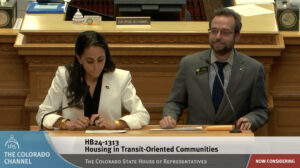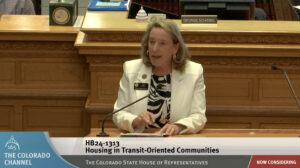Gov. Jared Polis advanced his affordable-housing package in several big ways in recent days — including signing the first bill that is part of it into law on Monday — though the lynchpin bill to the effort continues to face likely hurdles ahead.
And while a trio of long-discussed bills grabbed the spotlight and a lot of debate time on the House floor over an extended weekend, a potentially transformative new bill achieved something that none of those were able to get — unanimous backing. House Bill 1434, sponsored by Democratic Rep. Shannon Bird of Westminster, would triple the annual allotment for the affordable housing tax credit over the next few years, a move that drew praise from housing advocates, business groups and housing-development investors.
The action around the proposals ensures that, like 2023, housing will continue to be one of the most discussed topics through the end of the legislative session, at a time when employers say the affordability crisis is hurting their ability to attract and retain workers. But unlike last year, when the Democratic governor and his supporters put all their eggs in the basket of a single bill that failed on the final day, the new efforts are passing piecemeal, giving each a seemingly better chance of advancing on their own merits.
First affordable-housing bill becomes law
That’s particularly true for House Bill 1007, sponsored by Democratic Reps. Manny Rutinel of Commerce City and Javier Mabrey of Denver, which Polis signed into law on the west steps of the Capitol this afternoon. The bills bars cities from enacting or enforcing limits on the number of unrelated residents sharing an apartment or house, except where it’s necessary to regulate safety, health and welfare.
Municipal leaders and Republicans argued that it stomped on the planning and zoning rights of local governments and is, as Senate Minority Leader Paul Lundeen of Monument said, about governmental power “at its core, fundamental level.” But in extensive Senate debate, the biggest change they managed was to get sponsors to strike the legislative declaration explaining why the bill was needed.

Colorado state Rep. Manny Rutinel speaks about his bill on residential occupancy limits on Monday.
Speaking in front of a crowd of housing advocates, including college students and cooperative founders saying they deserve the right to live with people who share more than blood lines with them, Polis and sponsors said Monday that HB 1007 fights discrimination. But more to the point of this year’s legislative theme, it allows people to access housing more easily by being able to occupy all the bedrooms in a large home and by likely bringing down rental costs when sharing a space with so many other people.
“This is about freedom of choice in housing,” Mabrey said. “In the middle of a housing crisis, local governments should not be limiting housing options.”
House passes two bills to spur development
Another bill — HB 1152, sponsored by Democratic Rep. Judy Amabile of Boulder and Republican Rep. Ron Weinberg of Loveland — would allow urban homeowners the right to build an accessory dwelling unit on their property. The proposal, which also would create financing help for homeowners to do this and grant programs for cities to incorporate this into planning, received a modicum of bipartisan support, passing the House by a 43-19 margin on Sunday.
That day, House members also passed HB 1313, a measure to use both carrots and sticks to spur “transit-oriented communities” — multifamily development around bus and rail lines in 31 urban areas — by a 37-24 vote. However, pushback that the bill from Democratic Reps. Steven Woodrow of Denver and Iman Jodeh of Aurora received portends why many of the same moderate Democrats who brought about the demise of last year’s Senate Bill 213 are likely to fight this new iteration.
The bill requires cities and counties within metropolitan planning organizations that have a certain amount of acreage adjacent to rail and bus rapid transit lines to boost zoning to a minimum of 40 units per acre for the amount of land that fits into a designated TOC. Local governments can choose where that increased density goes, and they can employ various means — from increasing allowable building heights to permitting multifamily construction in areas zoned for single-family homes — but must create “housing opportunity goals.”

Colorado state Reps. Steven Woodrow and Iman Jodeh speak about their transit-oriented communities bill on the House floor Friday.
There are incentives to follow the new law, from a $35 million grant program for governments to help them plan out their TOCs to a new $30 million tax credit that mirrors the existing low-income housing tax credit. Backers like Housing Colorado Executive Director Brian Rossbert, called HB 1313 a “market-based approach to the development of housing” that overcomes government barriers to development like single-family zoning.
Transit-oriented communities bill faces opposition
But the “significant” stick, as Republican Rep. Lisa Frizell of Castle Rock described it, is its allowance for the state to withhold Highway Users Tax Fund money from governments that fail to comply with its requirements, a pot totaling several hundred million dollars. This is money that not only makes up half of some city and county road and bridge budgets, explained Arapahoe County Commissioner Jessica Campbell-Swanson, but that is used for the bike and roadway projects critical to transit-oriented development.
“You are punishing that community, but you are also punishing anyone who drives through that community,” lamented Reagan Shane, legislative and policy advocate for Colorado Counties Inc, in a March 25 House Finance Committee hearing. “It could endanger lives.”

Colorado state Rep. Lisa Frizell speaks against the transit-oriented communities bill in the House on Friday.
Frizell tried both in that committee and on the House floor to remove the HUTF penalty, which bill backers have said is a necessary step to give HB 1313 some teeth. She fell one vote short in committee, with Rep. Marc Snyder, D-Manitou Springs, agreeing to leave it in the bill only on the promise that sponsors would keep looking for ways to remove it.
Woodrow and Jodeh also are attempting to stave off concerns from more progressive members of their caucus that they haven’t specified any percentage of new development that would have to be set aside for income-restricted or otherwise affordable housing. And they’ve managed to navigate the bill through its first chamber by emphasizing that such big steps are needed to spur significant new construction for people who want to live in smaller and cheaper units or without a car.
Affordable-housing tax credit stokes interest
“Colorado is in a housing crisis,” Woodrow said Friday on the House floor. “Young adults can’t afford rent … And seniors are being pushed out.”
Just about the only policy that seems to be garnering a large amount of bipartisan support right now is HB 1434, which passed through the House Finance Committee on Thursday by an 11-0 tally. It’s slated for its next hearing in the House Appropriations Committee.
The bill would add $20 million in tax credits annually from 2024-26, $16 million annually from 2027-29 and $10 million in 2030 and 2031 to the existing $10 million in yearly funding for the credits. To spur construction quickly, it would require that qualified taxpayers, who typically sell the credits to investors in exchange for the cash needed to build, claim 70% of the amount of the new credit resources in the first year of the credit period and claim the remainder within the following five years.

Colorado state Rep. Shannon Bird answers a question from Rep. Anthony Hartsook in a committee Thursday regarding her affordable-housing tax-credit bill.
Business leaders back affordable-housing tax credit
The affordable housing tax credit has spawned 11,000 new units by drawing in $1.7 billion in private investment since it last was renewed in 2014, said Jerilynn Francis, Colorado Housing and Finance Authority chief communications and community partnerships officer. It ensures investors that even if they won’t receive as large a return as they would with market-rate housing, they can look to a track record of steady returns and use the credits to cover the gap between market rate and below-market rate, several told the committee.
The “proven” program is needed even more as business leaders cite housing affordability as their second-largest concern, behind regulations, for expanding in-state, said Meghan Dollar, Colorado Chamber of Commerce senior vice president of government relations. It is an example of where the government and private sector can work together to achieve a shared goal, she and others said.
“We’ve seen the failure of public housing,” Snyder said, pointing to both the crime-filled Cabrini Green project in Chicago and Soviet-style housing where he said there was no investment by people who live there. “This is truly, I consider, a public-private partnership.”
